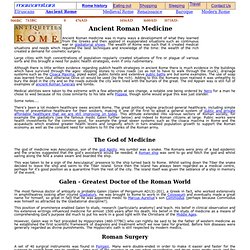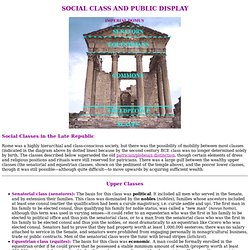

Daily Life in Ancient Rome - Welcome to Ancient Rome! Daily life in ancient rome. Ancient Roman Medicine. EtruscansAncient RomeMedieval RomeRenaissanceBaroqueModern Rome Ancient Roman medicine was in many ways a development of what they learned from the Greeks and then applied in exasperated situations such as continuous war or gladiatorial shows.

The wealth of Rome was such that it created medical situations and needs which required the best techniques and knowledge of the time: the wealth of the rich created a demand for cosmetic surgery. Large cities with high concentrations of population regularly created situations of fire or plague of various sorts and this brought a need for public health strategies, even if only rudimentary. Medical abilities were taken to the extreme with a few attempts at sex change, a notable one being ordered by Nero for a man he chose to wed because of his close similarity to his late wife Poppea, though some would argue this was just slander. Some notes.... There's been a lot modern healthcare owes ancient Rome. Roman Style Garden in Italy.
Essentials to a Roman Style Garden There is a considerable body of evidence surrounding the gardens of ancient Rome that details the various elements that comprised their pleasure and villa style gardens.

Many classical features are found in today's gardens and landscapes paying homage to those ancient stylized Roman gardens. The following article discusses ways you can transform your garden or landscape into an ancient Roman pleasure garden filled with elements reminiscent of that glorious past. roman garden fountain While inhabitants of the city of Rome frequently employed courtyard ( as above) and kitchen gardens, it was the inhabitants of the Roman countryside who perfected the pleasure garden that ancient Roman villas are noted for. The overlying ideal of the pleasure garden was for relaxation and rejuvenation.
Most Roman villas featured a transition element between the house and the garden. There most likely would have been a dining area—low tables with low couches. Roman Nomenclature. Roman Social Class and Public Display. Social Classes in the Late Republic Rome was a highly hierarchial and class-conscious society, but there was the possibility of mobility between most classes (indicated in the diagram above by dotted lines) because by the second century BCE class was no longer determined solely by birth.

The classes described below superseded the old patrician/plebeian distinction, though certain elements of dress and religious positions and rituals were still reserved for patricians. There was a large gulf between the wealthy upper classes (the senatorial and equestrian classes, shown on the pediment of the temple above), and the poorer lower classes, though it was still possible—although quite difficult—to move upwards by acquiring sufficient wealth. Upper Classes Senatorial class (senatores): The basis for this class was political.
Lower Classes Commons (plebs or vulgus): all other freeborn Roman citizens. Gateway to Pompeii, companion site for A.D.62: Pompeii, a novel. Visit the web pages below to see illustrations from ancient works of art that inspired the descriptions of people and places in the novel.

Other sites include an interactive map of Pompeii, travel information, and information about replicas of ancient artifacts. A.D. 62: Pompeii, a novel set in Pompeii Ancient Art described in the novel: Murals and Mosaics Archaeological Digs Archaeology Magazine: Explore the human past with the premiere publication devoted to worldwide archaeological discovery. Artifacts and Objects described in the novel Breakfast with Pandora: A trained expert delivers essays and information, and answers your questions on Greek mythology, religion, and the ancient world in general.
Who was Who in Roman Times. The Roman Gladiator: The Rock Star of the Roman Empire. A gladiator was a professional fighter who fought other gladiators and even animals in amphitheaters around the Roman Republic and Roman Empire.

Gladiators fought for over 600 years of Rome’s history, evolving from modest ceremonial combats into grand entertainment spectaculars, filled with violence and gore. These battles, often fought to a bloody death, were adored by the Roman citizens, as were the gladiators themselves. The word gladiator comes from the Latin gladiatores, or “swordsmen”, taken from the Latin word gladius, which was a short sword used by the legionaries. Gladiators were by no means as high ranking on the Roman status ladder as a soldier, but they were nonetheless regarded highly in Roman society. Gladiators were usually slaves or war prisoners who were bought by a lanista (a manager and trainer of gladiators) in order to be trained as proper gladiators. Gladiators were professionals, and were paid after each fight.
Source consulted: